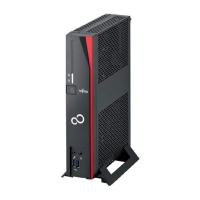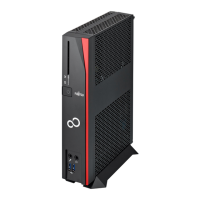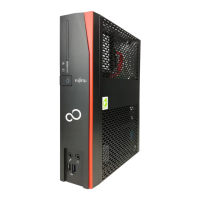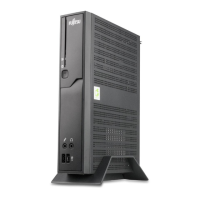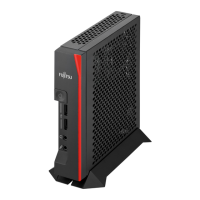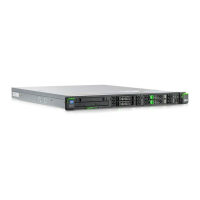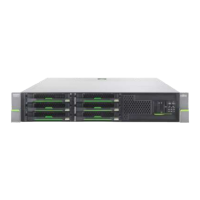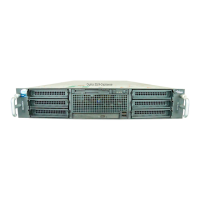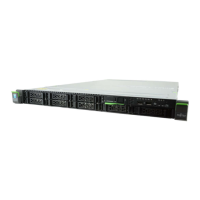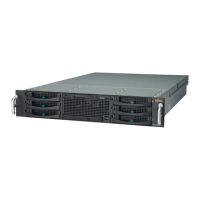Do you have a question about the Fujitsu FUTRO S940 and is the answer not in the manual?
Overview of the front panel ports and controls of the Thin Client.
Details of the ports and connectors on the rear panel of the device.
Explains security features like the Kensington Lock device.
Instructions for attaching optional covers to USB ports.
Crucial safety information for device installation and operation.
Notes on device setup when using a Power over Ethernet module.
Guidelines for safely moving the device from one location to another.
Procedures and precautions for cleaning the device's exterior.
Information on power efficiency and environmental considerations.
Initial steps for device installation and placement.
How to set up the device for upright use.
Instructions for placing the device on its side.
General guidance on connecting peripherals to the device.
Detailed identification of all available ports on the device.
Steps for connecting a display to the Thin Client.
How to connect USB or PS/2 mice to the device.
Instructions for connecting USB or PS/2 keyboards.
Guide for connecting devices via the serial port.
How to connect peripherals using USB ports.
Connecting audio devices to the relevant ports.
Steps to connect the device to a local area network.
Instructions for connecting the power supply.
Procedure for powering on the Thin Client.
Overview of supported OS and management solutions.
Details about the eLux Thin Client operating system.
Information on the Windows 10 IoT Enterprise OS.
Features of the management solution for Thin Clients.
Proper procedures for shutting down the device.
How to enable energy-saving features via BIOS.
Steps to access and navigate the BIOS setup utility.
Configuration for booting from a network using PXE.
When and how to update the system's BIOS.
Adjusting system configurations based on OS documentation.
Methods for updating system software.
Safety warnings for device maintenance and component handling.
Information on installing component holders for expansions.
Table showing compatible optional hardware components.
Precautions and guidelines for handling internal boards.
Step-by-step guide to accessing the device's interior.
Instructions for installing or removing memory modules.
Procedures for installing/removing the optional SmartCard reader.
Steps for adding or removing a USB port.
How to install or remove the optional loudspeaker.
Guide for installing/removing the PoE module.
Procedures for installing/removing PCI/PCIe expansion boards.
Steps for installing or removing the internal PSU.
Instructions for safely replacing the CMOS battery.
Steps for reassembling the device after expansion work.
Specifications for processor, voltage, and current.
Physical size and weight of the device in different configurations.
Operating temperature and clearance requirements.
Details of the external AC adapter used with the device.
Information on the internal power supply adapter.
Overview of the front panel ports and controls of the Thin Client.
Details of the ports and connectors on the rear panel of the device.
Explains security features like the Kensington Lock device.
Instructions for attaching optional covers to USB ports.
Crucial safety information for device installation and operation.
Notes on device setup when using a Power over Ethernet module.
Guidelines for safely moving the device from one location to another.
Procedures and precautions for cleaning the device's exterior.
Information on power efficiency and environmental considerations.
Initial steps for device installation and placement.
How to set up the device for upright use.
Instructions for placing the device on its side.
General guidance on connecting peripherals to the device.
Detailed identification of all available ports on the device.
Steps for connecting a display to the Thin Client.
How to connect USB or PS/2 mice to the device.
Instructions for connecting USB or PS/2 keyboards.
Guide for connecting devices via the serial port.
How to connect peripherals using USB ports.
Connecting audio devices to the relevant ports.
Steps to connect the device to a local area network.
Instructions for connecting the power supply.
Procedure for powering on the Thin Client.
Overview of supported OS and management solutions.
Details about the eLux Thin Client operating system.
Information on the Windows 10 IoT Enterprise OS.
Features of the management solution for Thin Clients.
Proper procedures for shutting down the device.
How to enable energy-saving features via BIOS.
Steps to access and navigate the BIOS setup utility.
Configuration for booting from a network using PXE.
When and how to update the system's BIOS.
Adjusting system configurations based on OS documentation.
Methods for updating system software.
Safety warnings for device maintenance and component handling.
Information on installing component holders for expansions.
Table showing compatible optional hardware components.
Precautions and guidelines for handling internal boards.
Step-by-step guide to accessing the device's interior.
Instructions for installing or removing memory modules.
Procedures for installing/removing the optional SmartCard reader.
Steps for adding or removing a USB port.
How to install or remove the optional loudspeaker.
Guide for installing/removing the PoE module.
Procedures for installing/removing PCI/PCIe expansion boards.
Steps for installing or removing the internal PSU.
Instructions for safely replacing the CMOS battery.
Steps for reassembling the device after expansion work.
Specifications for processor, voltage, and current.
Physical size and weight of the device in different configurations.
Operating temperature and clearance requirements.
Details of the external AC adapter used with the device.
Information on the internal power supply adapter.
| HD type | Not supported |
|---|---|
| Screen shape | - |
| LED backlight | No |
| Display diagonal | - \ |
| Display resolution | - pixels |
| Stepping | B0 |
| Tjunction | 105 °C |
| Processor code | SR3S3 |
| Processor cache | 4 MB |
| Processor cores | 4 |
| Processor model | J5005 |
| System bus rate | - GT/s |
| Processor family | Intel® Pentium® |
| Processor socket | BGA 1090 |
| Processor codename | Gemini Lake |
| Processor frequency | 1.50 GHz |
| Processor cache type | L3 |
| Processor lithography | 14 nm |
| Conflict-Free processor | Yes |
| PCI Express slots version | 2.0 |
| Processor boost frequency | 2.80 GHz |
| Processor operating modes | 32-bit, 64-bit |
| PCI Express configurations | 4x1 |
| Thermal Design Power (TDP) | 10 W |
| Maximum number of PCI Express lanes | 6 |
| Memory types supported by processor | DDR4-SDRAM, LPDDR4-SDRAM |
| Memory channels supported by processor | Dual |
| Memory clock speeds supported by processor | 2400 MHz |
| Maximum internal memory supported by processor | 8 GB |
| Internal memory | 4 GB |
| Memory slots type | SO-DIMM |
| Internal memory type | DDR4-SDRAM |
| Maximum internal memory | 16 GB |
| Memory layout (slots x size) | 1 x 4 GB |
| SSD capacity | The Solid State Drive's storage capacity in Gigabytes. |
| SSD interface | SATA |
| Storage media | SSD |
| SSD form factor | M.2 |
| Number of storage drives installed | 1 |
| Number of execution units | 18 |
| On-board graphics card ID | 0x3184 |
| Discrete graphics card model | Not available |
| On-board graphics card model | Intel® UHD Graphics 605 |
| On-board graphics card family | Intel® UHD Graphics |
| On-board graphics card OpenGL version | 4.4 |
| On-board graphics card base frequency | 250 MHz |
| On-board graphics card DirectX version | 12.0 |
| On-board graphics card dynamic frequency (max) | 800 MHz |
| Number of displays supported (on-board graphics) | 3 |
| AC input frequency | 50 - 60 Hz |
| AC adapter frequency | 50/60 Hz |
| AC adapter input voltage | 100 - 240 V |
| Audio chip | Realtek ALC671 |
| Ethernet LAN data rates | 10, 100, 1000 Mbit/s |
| USB 2.0 ports quantity | USB 2.0 ports have a data transmission speed of 480 Mbps, and are backwards compatible with USB 1.1 ports. You can connect all kinds of peripheral devices to them. |
| USB 3.2 Gen 1 (3.1 Gen 1) Type-A ports quantity | 2 |
| Motherboard ARK ID | D3543-A |
| Operating temperature (T-T) | 10 - 35 °C |
| Operating relative humidity (H-H) | 5 - 85 % |
| Sustainability certificates | EPEAT Gold |
| Product color | Black |
| Product type | All-in-One workstation |
| Processor ARK ID | 128984 |
| Processor package size | 25 x 24 mm |
| Depth (with stand) | 193 mm |
|---|---|
| Width (with stand) | 90 mm |
| Height (with stand) | 261 mm |
| Weight (with stand) | - g |
| Width (without stand) | 52 mm |
| Height (without stand) | 250 mm |
